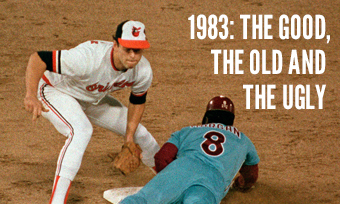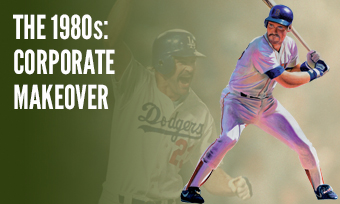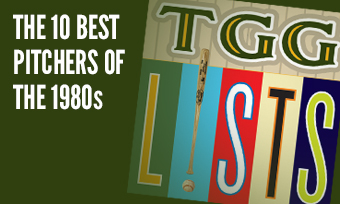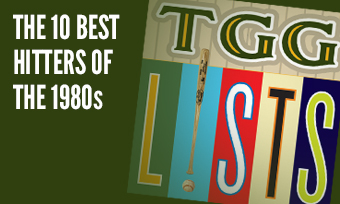The Yearly Reader
Leaders and Honors, 1983
Our list of baseball’s top 10 hitters and pitchers in both the American League and National League for the 1983 baseball season, as well as the awards and honors given to the game’s top achievers of the year.
The National League’s Top 10 Hitters, 1983
Bold type in brick red indicates league leader.
1. Dale Murphy, Atlanta
Key Numbers: 162 games, .302 average, 131 runs, 178 hit, 36 home runs, 121 RBIs, 90 walks, 30 stolen bases, .540 slugging percentagebases.
Slow-footed by appearance, back-to-back NL MVP winner Murphy was a true deceiver of speed and became the game’s unlikeliest entrant into the 30-30 club.
2. Tim Raines, Montreal
Key Numbers: .298 average, 133 runs, 183 hits, 32 doubles, 8 triples, 11 home runs, 71 RBIs, 97 walks, 90 stolen bases, 14 caught stealing.
Cleaned up after spending $1,000 a week on cocaine, the Rock set career highs in steals, runs, walks and RBIs.
3. Andre Dawson, Montreal
Key Numbers: .299 average, 104 runs, 189 hits, 36 doubles, 10 triples, 32 home runs, 113 RBIs, 9 hit-by-pitches, 25 stolen bases, 18 sacrifice flies.
Dawson reached the megastar status long predicted of him, unarguably putting together his most complete set of numbers—though his most memorable campaign still lay ahead. (See 1987.)
4. Mike Schmidt, Philadelphia
Key Numbers: .255 average, 104 runs, 40 home runs, 109 RBIs, 128 walks, 148 strikeouts, .399 on-base percentage.
One of the younger Phillies at age 33, Schmidt led the NL in home runs for the sixth time and led the circuit in on-base percentage for a third straight year.
5. Pedro Guerrero, Los Angeles
Key Numbers: .298 average, 87 runs, 174 hits, 28 doubles, 6 triples, 32 home runs, 103 RBIs, 23 stolen bases.
Guerrero’s superior production remained unaffected as he struggled to adapt to a full-time move to third base, replacing long-time Dodger Ron Cey.
6. Jose Cruz, Houston
Key Numbers: .318 average, 85 runs, 189 hits, 28 doubles, 8 triples, 14 home runs, 92 RBIs, 30 stolen bases.
One of the most popular players to wear an Astro uniform, Cruz hit a career-high .318 even as he passed into baseball’s old age (upper 30s) because, as he said, “getting tired is mental.” He went hitless in his final eight at-bats to squander his chances of winning a batting title.
7. Darrell Evans, San Francisco
Key Numbers: .277 average, 94 runs, 29 doubles, 30 home runs, 82 RBIs, 84 walks.
The 36-year-old Evans suddenly awoke from a decade of slugging mediocrity that followed his 41-homer campaign of 1973.
8. George Hendrick, St. Louis
Key Numbers: .318 average, 33 doubles, 18 home runs, 97 RBIs.
In a time when the Cardinals were focusing less on power and more on speed, Hendrick seemed out of place—but when you hit .318 at age 33, no one’s going to call you out as odd.
9. Gary Redus, Cincinnati
Key Numbers: 125 games, .247 average, 90 runs, 20 doubles, 9 triples, 17 home runs, 51 RBIs, 71 walks, 39 stolen bases.
In his first full year with the Reds, the speedy outfielder with decent pop showed much of the same skills that would soon behold Eric Davis at Cincinnati.
10. Dickie Thon, Houston
Key Numbers: .286 average, 81 runs, 177 hits, 28 doubles 9 triples, 20 home runs, 79 RBIs, 34 stolen bases.
A young, rising All-Star shortstop, Thon briefly blossomed before a beaning seriously curtailed his career with blurred vision.
The American League’s Top 10 Hitters, 1983
1. Eddie Murray, Baltimore
Key Numbers: .306 average, 115 runs, 178 hits, 30 doubles, 33 home runs, 111 RBIs, 86 walks.
The back-to-back runner-up for the AL MVP, Murray hit a career-high 33 homers—a rather low tally for someone who’d eventually belt over 500.
2. Rickey Henderson, Oakland
Key Numbers: .292 average, 105 runs, 25 doubles, 7 triples, 9 home runs, 48 RBIs, 103 walks, 108 stolen bases, 19 caught stealing.
Henderson became the first player to steal 100 bases in consecutive years; 12 times, he swiped at least three in a game.
3. Willie Upshaw, Toronto
Key Numbers: .306 average, 99 runs, 177 hits, 26 doubles, 7 triples, 27 home runs, 104 RBIs, 10 stolen bases.
In what would become a top-of-the-line effort, Upshaw became the first Blue Jay to knock in 100 runs—and he could have had more; 19 of his 27 home runs were drilled with no one on base.
4. George Brett, Kansas City
Key Numbers: 123 games, .310 average, 90 runs, 38 doubles, 25 home runs, 93 RBIs, .563 slugging percentage.
Whether he had too much pine-tar or not on his bat, Brett raised the bar on a career high for home runs; he certainly would have added to it had he not been absent from 39 games.
5. Wade Boggs, Boston
Key Numbers: .361 average, 100 runs, 210 hits, 44 doubles, 7 triples, 5 home runs, 74 RBIs, 92 walks, .444 on-base percentage.
Proving that his part-time .349 rookie average from 1982 was no fluke, Boggs partly attributed his first AL batting crown to his daily consumption of chicken—just one of his many superstitions.
6. Cecil Cooper, Milwaukee
Key Numbers: .307 average, 661 at-bats, 106 runs, 203 hits, 37 doubles, 30 home runs, 126 RBIs.
An outstanding, under-the-radar run of excellence was capped as Cooper finished a seven-year stretch hitting .316 with a season average of 22 home runs and 95 RBIs.
7. Lloyd Moseby, Toronto
Key Numbers: .315 average, 104 runs, 170 hits, 31 doubles, 7 triples, 18 home runs, 81 RBIs, 27 stolen bases.
Representative of a new breed of Blue Jay, Moseby was the first player to score 100 runs for Toronto.
8. Cal Ripken Jr., Baltimore
Key Numbers: 162 games, .318 average, 663 at-bats, 121 runs, 211 hits, 47 doubles, 27 home runs, 102 RBIs, 28 grounded into double plays.
Playing every game, let along every inning, hardly wore the young Ripken down; he hit .361 from mid-July on.
9. Jim Rice, Boston
Key Numbers: .305 average, 90 runs, 191 hits, 34 doubles, 39 home runs, 126 RBIs, 31 grounded into double plays.
Rice erupted with the kind of numbers that haunted pitchers during his reign of terror in the late 1970s.
10. Robin Yount, Milwaukee
Key Numbers: .308 average, 102 runs, 178 hits, 42 doubles, 10 triples, 17 home runs, 80 RBIs, 12 stolen bases.
The reigning AL MVP remained potent even as wary opponents began pitching around him; he drew 72 walks as opposed to just 26 three years earlier.
The National League’s Top 10 Pitchers, 1983
1. John Denny, Philadelphia
Key Numbers: 2.37 ERA, 19 wins, 6 losses, .760 win percentage, 36 starts, 242.2 innings, 53 walks, 12 stolen bases allowed, 19 caught stealing/picked off, 27 grounded into double plays.
The NL finished without a 20-game winner for the first time in 52 years, although Denny came awfully close, winning his last six starts.
2. Mario Soto, Cincinnati
Key Numbers: 2.70 ERA, 17 wins, 13 losses, 34 starts, 18 complete games, 273.2 innings.
Soto was Cincinnati’s stopper for the second straight year; with the Reds losing so often, he had no choice.
3. Bob Welch, Los Angeles
Key Numbers: 2.65 ERA, 15 wins, 12 losses, 31 starts, 204 innings, 7 stolen bases allowed, 17 caught stealing/picked off.
Getting better with each year, Welch got better with each month in 1983—thriving down the stretch to finish above .500. It should have been easier; the Dodgers scored two runs or less in 12 of his starts.
4. Atlee Hammaker, San Francisco
Key Numbers: 2.25 ERA, 10 wins, 9 losses, 23 starts, 172.1 innings, 32 walks.
The unassuming southpaw was solid gold in the season’s first half with a 9-4 record and 1.70 ERA—but then he gave up the first grand slam in All-Star Game history, and a sore arm dogged his second half. Despite hanging in the majors for another decade, he never got his career back on solid footing.
5. Alejandro Pena, Los Angeles
Key Numbers: 2.75 ERA, 12 wins, 9 losses, 1 save, 1 blown save, 34 appearances, 26 starts, 177 innings.
After a strong start coming out of the bullpen, Pena was moved to the rotation where he gave excellent backend support to the Dodgers’ aces.
6. Steve Rogers, Montreal
Key Numbers: 3.23 ERA, 17 wins, 12 losses, 36 starts, 5 shutouts, 273 innings, 21 stolen bases allowed, 19 caught stealing/picked off.
In his last full year before shoulder injuries doomed his career at age 35, Rogers helped his own cause at the plate by leading the majors with 20 sacrifice bunts.
7. Jesse Orosco, New York
Key Numbers: 1.47 ERA, 13 wins, 7 losses, 17 saves, 5 blown saves, 62 appearances, 110 innings.
Of the many, many years (24 in all, until age 46) that Orosco would pitch, none was finer than his 1983 effort.
8. Craig McMurtry, Atlanta
Key Numbers: 3.08 ERA, 15 wins, 9 losses, 35 starts, 224.2 innings, 23 stolen bases allowed, 21 grounded into double plays.
McMurtry’s promising rookie effort would be followed in later years by disappointment, injury and the stigma of allowing Barry Bonds’ first career home run.
9. Nolan Ryan, Houston
Key Numbers: 2.98 ERA, 14 wins, 9 losses, 29 starts, 196.1 innings, 101 walks, 21 stolen bases allowed, 20 grounded into double plays.
The Ryan Express wasn’t quite at top speed as his strikeout rate went down and his walk rate went up—but he was still tough to get a hit off of; for the third straight year, he had the lowest opposing batting average (.195).
10. Steve Carlton, Philadelphia
Key Numbers: 3.11 ERA, 15 wins, 16 losses, 37 starts, 283.2 innings, 275 strikeouts, 13 wild pitches, 9 balks, 19 stolen bases allowed, 19 caught stealing/picked off.
The head-scratcher of the season; although Carlton’s ERA remained virtually unmoved from his 23-11 performance of the year before, he finished with a losing record. Only one NL pitcher (the Mets’ Mike Torrez) lost more games.
The American League’s Top 10 Pitchers, 1983
1. Dan Quisenberry, Kansas City
Key Numbers: 1.94 ERA, 5 wins, 3 losses, 45 saves, 8 blown saves, 69 appearances, 139 innings, 11 walks, 19 grounded into double plays.
Quisenberry remained the AL’s toughest closer on the mound, shattering the decade-old season record for saves.
2. Dave Stieb, Toronto
Key Numbers: 3.04 ERA, 17 wins, 12 losses, 36 starts, 278 innings, 14 wild pitches.
Stieb set the pace for another sturdy campaign by starting the season at 8-2 with a 1.04 ERA.
3. Rick Honeycutt, Texas
Key Numbers: 2.42 ERA, 14 wins, 8 losses, 25 starts, 174.2 innings, 37 walks, 30 grounded into double plays.
The lefty turned it all around after a dreadful (5-17, 5.27 ERA) 1983 campaign, all but sewing up the AL ERA crown when he was traded to the contending Dodgers in mid-August. (He bombed late in Los Angeles, posting a 2-3 record and 5.77 ERA.)
4. LaMarr Hoyt, Chicago
Key Numbers: 3.66 ERA, 24 wins, 10 losses, .706 win percentage, 36 starts, 260.2 innings, 33 walks, 22 grounded into double plays.
With a 13-0 record over his last 14 starts, Hoyt’s season total of 24 tied Wilbur Wood (from 1972-73) for the most in a season by a White Sox pitcher since Red Faber in 1921.
5. Mike Boddicker, Baltimore
Key Numbers: 2.77 ERA, 16 wins, 8 losses, 26 starts, 5 shutouts, 179 innings.
As good as the rookie righty was during the season, Boddicker saved his best start for the playoffs; his 14 strikeouts of the White Sox during a five-hit shutout in ALCS Game Two were the most by an American Leaguer all year.
6. Jack Morris, Detroit
Key Numbers: 3.34 ERA, 20 wins, 13 losses, 37 starts, 20 complete games, 293.2 innings, 232 strikeouts, 18 wild pitches.
The Hall-of-Fame ace wore the workhorse more than ever, setting career highs in innings thrown, starts, complete games and strikeouts.
7. Rich Dotson, Chicago
Key Numbers: 3.22 ERA, 22 wins, 7 losses, .759 win percentage, 106 walks, 29 stolen bases allowed, 33 grounded into double plays.
After three common years at Comiskey Park, Dotson shelved his slider, broke out a curve, and produced a career-year showing for the ‘ugly’ White Sox.
8. Charlie Hough, Texas
Key Numbers: 3.18 ERA, 15 wins, 13 losses, 33 starts, 252 innings, 19 stolen bases allowed, 20 caught stealing/picked off, 22 grounded into double plays.
Pitching his 14th year in the majors—but only his second as a full-time starter—Hough used his knuckler to befuddle opposing hitters—and often, his own catchers. His streak of 37.1 consecutive scoreless innings set a Texas record, later broken by Kenny Rogers.
9. Moose Haas, Milwaukee
Key Numbers: 3.27 ERA, 13 wins, 3 losses, .813 win percentage, 25 starts, 179 innings, 42 walks.
In his eighth year at the Brewers, Haas sprung forward and got better as the year went along, winning five starts and tossing 29 consecutive scoreless innings in August before arm pains put an early end to his season.
10. Ron Guidry, New York
Key Numbers: 3.42 ERA, 21 wins, 9 losses, 21 complete games, .700 win percentage, 31 starts, 250.1 innings.
Two years after failing to complete a single one of his 21 starts, Guidry led the majors in going the distance.









